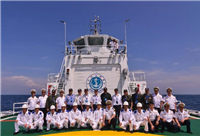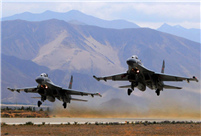

DUBAI, March 12 -- With Chinese currency the yuan, also known as the renminbi, enjoying rising acceptance, banks and enterprises in the Gulf Arab region are seeking ways to catalyze the growing demand for conducting trade with the currency.
"By the end of 2014, the yuan has become the world's seventh largest payment currency and the ninth largest trading currency," Tian Jun, general manager of Abu Dhabi branch of Bank of China, said at a one-day seminar on Thursday.
"The yuan gradually becomes a new choice for some countries in reserve diversification," said the banker.
China's yuan, once an almost unknown currency in the daily economic life in the Gulf Arab region, is enjoying rising acceptance across the area.
The United Arab Emirates (UAE) is the biggest export market for Chinese goods in the region, and the leading local and foreign banks in the oil-rich Gulf state, such as Dubai's Emirates NBD and British lender HSBC, have recently started to expand their product portfolio to provide accounts or trade financing in the Chinese currency.
Tian quoted a global clients' survey as saying that over 50 percent of the interviewees believe the cross-border renminbi settlement will account for 20 to 30 percent in the next five years, and 61 percent intend to use the renminbi in cross-border trade or increase the proportion of renminbi settlement.
Kawal Singh Kohli, manager and board member at Dina Investment in Dubai, said his company plans to use the renminbi accounts within the next three months.
"We bring exporters in the UAE and importers in China together and organize trade financing. We also use bank services from Chinese banks in Dubai to conduct trade between the UAE firms and their trade partners in other countries in the region," the manager said.
Vincent Cheung, head of the global market trading division at Bank of China in Hong Kong, said the renminbi also receives tailwinds from China's domestic economy such as the launch of the Shanghai Free Trade Zone in July 2014.
Cheung said the Belt and Road Initiatives, China's ambitious trans-Eurasia and across-ocean trade strategy, launched last year, will also push the internationalization of the global renminbi trade.
He also noted that there was a significant development in market liquidity illustrated by a notable spread compression in the exchange rates between the renminbi and other currencies.
"The liquidity is comparable to euro to U.S. dollar or Australian dollar to U.S. dollar. The average daily volume of interbank foreign exchange and money market transactions in offshore renminbi transaction equals 35 billion U.S. dollars, which is one of the most active currencies traded in Asian trading hours," Cheung said.
Nasser Saidi, former chief economist of the Dubai International Financial Center, also painted a bright future for the renminbi in an early exclusive interview with Xinhua.
"The growing internationalization of the renminbi, supported by bilateral currency-swap agreements and the recently announced BRICS development bank and contingency fund, is bound to be the forerunner of a new multi-currency world, thereby breaking the hegemony of the U.S. dollar and accentuating the dominance of China in the global landscape," he said.
Saidi said there will be a shift in soft power which will start in three main financial developments in the coming decade. "A change in the governance of the international monetary and financial architecture, the growth of 'renminbisation' and the emergence of Chinese capital markets to rival London and New York to serve the emerging economies."
In 2013, the global payment transaction services institution SWIFT reported the renminbi would overtake the euro to become the second most-used currency in global trade finance, said Cheung.
The "big four" Chinese bank leaders, Industrial and Commercial Bank of China, Agricultural Bank of China, Bank of China and China Construction Bank, have opened branch offices in the Dubai banking freezone DIFC since 2008.
In November 2014, Industrial and Commercial Bank of China's branches in Doha and Qatar became the first renminbi clearing bank in the Gulf Arab region and the Middle East.
Several global financial centers, such as Hong Kong, London and Frankfurt, have also established renminbi offshore trading centers in recent years.
 Beijing's toughest anti-smoking law takes effect
Beijing's toughest anti-smoking law takes effect Attendants-to-be join Mr. & Miss Campus Contest
Attendants-to-be join Mr. & Miss Campus Contest China hosts overseas disaster relief exercise for the first time
China hosts overseas disaster relief exercise for the first time J-11 fighters in air exercise
J-11 fighters in air exercise PLA soldiers operating vehicle-mounted guns in drill
PLA soldiers operating vehicle-mounted guns in drill Beauties dancing on the rings
Beauties dancing on the rings 20 pairs of twins who will become flight attendants in Sichuan
20 pairs of twins who will become flight attendants in Sichuan Blind carpenter in E China's Jiangxi
Blind carpenter in E China's Jiangxi Top 10 highest-paid sports teams in the world
Top 10 highest-paid sports teams in the world Obama is sowing discontent in S.China Sea
Obama is sowing discontent in S.China Sea Rescuers work through night to reach cruise ship survivors
Rescuers work through night to reach cruise ship survivors Driving through limbo
Driving through limbo Facing down MERS
Facing down MERSDay|Week